*We are a reader-supported website. When you buy through links on our site, we may earn a small affiliate commission at no extra cost to you. Home Media Entertainment does not accept money for reviews.*
After looking in detail into many of Samsung’s TVs it is now time in our LG TVs for 2020 article to look into what LG has done with their new 2020 releases that includes an extensive lineup of both 8K and 4K resolution TVs in both OLED and LED LCD variants. It seems as we saw in Samsung’s case manufacturers are starting to release more and more 8K TVs and they have started to occupy more space in their new release schedule but with 8K content still absent it feels like these sets are there mostly to make consumers aware of this new technology rather than offering anything substantial at the moment.
Until we see real 8K content being released we wouldn’t say there is any real value on these sets except from the few that always want to have the latest in technology. And until 8K content becomes widely available rest assured that there will be much better 8K TVs out there in a few years time.
OLED is the King
LG has refreshed their OLED lineup this year and has no less than five models, six if you include the rollable LG RX. With the BX, CX, GX and WX comprising the 4K OLED lineup and the LG ZX being the only 8K OLED from LG this year. All the OLEDs come with the updated, third generation a9 AI processor while the ZX features an 8K variant of the same chip and the more budget friendly BX features the less capable a7 Gen 3 processor.
There are a few more features that are common among all the OLEDs and these include Dolby Vision and Dolby Atmos support while all of them have HDMI 2.1 ports with eARC support along with some new features like ALLM and VRR (except from the WX and RX models).
NanoCell TVs for the masses
And while LG has strongly supported OLED the past few years they never turned their backs to the other competing technology which is no other than LED LCD. LG has split this into two categories with the more premium one called NanoCell and for 2020 we get a refresh that includes an expanded 8K lineup along with updates on their 4K sets.
The NanoCell lineup features three 8K resolution TVs and five 4K resolution ones with all of them being equipped with IPS panels as per usual for LG. Some of these sets use the better Full Array with Local Dimming (FALD) light system for better and more accurate light control while some of the lower tier models have to settle for the less effective Edge LED system with Local Dimming.
All the 8K NanoCells come with the α9 Gen3 AI Processor 8K while most of the 4K variants feature the less capable α7 Gen 3 Processor 4K with only the NANO81/80 coming with a simpler quad core processor. Again most of these models support both Dolby Vision and Dolby Atmos and what is strange is that while the 4K TVs come with VRR support the 8K LCD TVs don’t. Lastly almost all of the NanoCells feature at least a couple of HDMI 2.1 ports which is natural to see as LG had started from last year making the new ports widely available.

4K UHD TVs for the price conscious
And while the OLED and NanoCell lineups boast some impressive specs and technologies LG hasn’t forgotten those that want a cheap TV to get the job done and there is a huge market out there that looks for a TV model that doesn’t necessarily pump impressive visuals but can still offer a respectable performance at a low cost.
That’s why we see no less that eight different models in this lineup with many of them using a mixture of IPS and VA panels, most of them feature a simple quad core processor 4K while all of them use a Direct LED light system and have the older HDMI 2.0 ports. No Dolby Vision or Dolby Atmos here except from the top UN85 model while there are a few models in the bottom of the lineup that even come with a cut down version of webOS that is missing several smart TV features.
Full HD is a thing of the past
It seems that 2020 will be the year that no new Full HD TVs will be released from LG as the low end 4K UHD TV lineup will fill that space and marks an end of an era for the Full HD TVs. It has been a hell of a ride and as technology pushes forward we are excited to see what comes next.
More tech analysis for 2020
LG has managed to create some very distinguishable differences between their three TV lineups. The OLED being obviously the cream of the crop featuring all the best and latest technologies and is mostly for those looking for the best image quality possible. The NanoCell on the other hand is a nice alternative for those that cannot afford to go the OLED way but still want respectable performance and some neat features at a lower price. Lastly the 4K UHD TV lineup is for those that want a cheap alternative and don’t care much about quality and image performance.
Now one thing that all these TVs share in common is LG’s smart TV platform that has reached it’s fifth iteration in 2020.

webOS 5.0
The webOS 5.0 is featured in every single 2020 TV release and for this year LG has included several tweaks and improvements including a new Home dashboard, a new Sports Alert feature that gives you updates on your favorite teams, start times, and scores even while you’re watching other content and improved search and recommendation capabilities.
With WebOS you can also have access to apps like Apple TV including their more premium Apple TV+ service, Airplay 2 and HomeKit. Overall we could say that the new webOS offers some interesting improvements and we are going to look into them in more detail in our reviews the following months but fundamentally webOS is the same old smart TV platform that we loved over the years.
If there is one downside that would be that webOS 5.0 will only be available in 2020 models which is a shame really as this means that many of these new features never manage to reach critical mass and remain only part of a more narrow audience.
A hands free future
With strong smart TV capabilities on many of these models you need the right tools to handle them. And voice control couldn’t be missing with some of the more higher tier models featuring built-in microphones on the main body of the TV for a completely hands free experience while most of the middle tier ones have to settle with the built-in microphone on the remote for issuing your commands.
As per usual LG’s ThinQ AI is present while you can also find Amazon Alexa or Google Assistant for your favorite voice control platform.

HDR Improvements
In the HDR arena LG for one more year remains firmly behind the Dolby Vision bandwagon so don’t expect to find HDR10+ anytime soon. For 2020 we get a new and improved dynamic tone-mapping for HDR, a new HGiG profile for HDR gaming that promises more accurate HDR in videogames and a new Filmmaker mode which promises to show content the way filmmakers intended to.
And in case you were wondering LG is dropping Technicolor’s Advanced HDR but this is hardly something anyone would miss as there is not any real content out there that could seriously back this format up so you cannot really consider this a backstep.
New Playback formats
Lastly it’s interesting to see many of the new 8K and 4K TVs, both OLEDs and NanoCells, support the new AV1 hardware decoding and we are curious to try this out in our upcoming testings. AV1 is a new codec from the Alliance for Open Media which includes some major names like Apple, Amazon and Google among others so we are excited to see how this will turn out in the future.
Closing
LG seems to have another strong year and with so many models released both in 8K and 4K in OLED and LED LCD variants there is a TV for all needs and all budgets. Below you can find details for each one of these models with their most important specifications while in the future we will be adding links to the individual reviews we will be making in many of them.
At the end of the article you can find comparison tables separated in three main categories with OLED, NanoCell and 4K UHD being created for your convenience and ease of comparison.
Before closing this part we should mention that you can check our New Product Lineups section for more reviews and articles which we will update as we manage to get our hands on these new releases.
So without further delay let’s analyze each model separately.
8K OLED TVs
LG ZX

Type : Flat
The LG ZX is the top flagship in LG’s arsenal for 2020 as it is the only 8K OLED available this year. In essence this is the second generation of 8K OLED with the 2019 variant being the first 8K OLED ever available. It comes in two sizes of 77″ and 88″ but both of them are extremely expensive and way above the capabilities of most consumers nowadays.
The LG ZX features an 8K OLED panel powered by the latest α9 Gen 3 AI Processor 8K and supports both Dolby Vision and Dolby Atmos. Some of the other available features include Dolby Vision IQ, Hands-free voice, Filmmaker Mode and HGiG Mode. It comes with HDMI 2.1 that supports all the new specs including ARC, eARC, VRR, FreeSync, G-Sync, ALLM and HFR.
For audio it comes equipped with a 4.2CH 80W audio system that features OLED Surround and AI Sound Pro. The ZX comes equipped with webOS 5.0 with all it’s smart TV and streaming capabilities including LG’s ThinQ AI, voice control and all the streaming services you can think of.
If you are looking for the top dog LG has to offer then the LG ZX is the one to look for, if you have the budget for such a TV of course.
Specifications
- 8K resolution (7,680 x 4,320)
- OLED display technology
- Wide Viewing Angle
- α9 Gen 3 AI Processor 8K
- HDR10, Dolby Vision, HLG
- 120Hz Refresh Rate
- VRR, FreeSync, G-Sync, ALLM, HFR
- 4.2CH 80W (77″ 60W) / Dolby Atmos, OLED Surround, AI Sound Pro
- Dolby Vision IQ, Hands-free voice, Filmmaker Mode, HGiG Mode
- 4 x HDMI 2.1 / 3 x USB 2.0
- ARC, eARC
- WiFi (802.11ac), Bluetooth v5.0
- webOS 5.0
- Google Assistant, Amazon Alexa, LG ThinQ AI
- ATSC 3.0 / DVB-T2/S2/C (Depending the region)
4K OLED TVs
LG WX
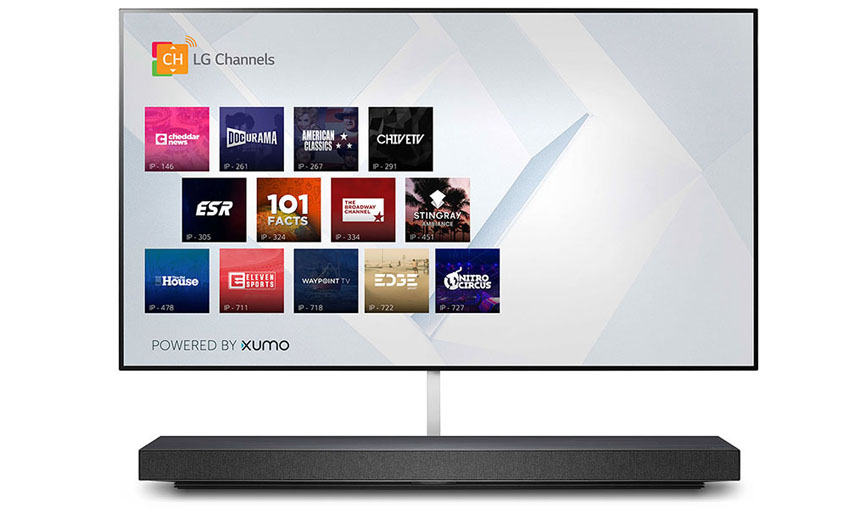
Type : Flat
Next in line is the LG WX which is LG’s wallpaper OLED featuring extremely thin borders and a redesigned soundbar for Dolby Atmos. We are entering 4K territory here as all OLEDs from here on are only 4K resolution. All other specs are very similar to the ZX but with some features strangely missing.
The LG WX features an OLED panel and comes with the same α9 Gen 3 AI Processor only here is the 4K variant of it. There is support for HDR10, Dolby Vision and HLG with additional features including Dolby Vision IQ, Hands-free voice, Filmmaker Mode and HGiG Mode. It also comes with HDMI 2.1 ports that include ARC and eARC along with ALLM and HFR but strangely the WX is missing VRR, FreeSync and G-Sync support that some other OLEDs do get.
For audio the included soundbar offer the TV a 4.2 channels audio system capable of 60 watts of power, supports Dolby Atmos, OLED Surround and AI Sound Pro while webOS 5.0 is available with the complete set of smart and streaming features available like LG’s ThinQ AI and voice control among others.
The LG WX is offered in just one size with 65″ being available.
Specifications
- 4K resolution (3,840 x 2,160)
- OLED display technology
- Wide Viewing Angle
- α9 Gen 3 AI Processor 4K
- HDR10, Dolby Vision, HLG
- 120Hz Refresh Rate
- ALLM, HFR
- 4.2CH 60W / Dolby Atmos, OLED Surround, AI Sound Pro
- Dolby Vision IQ, Hands-free voice, Filmmaker Mode, HGiG Mode
- 4 x HDMI 2.1 / 3 x USB 2.0
- ARC, eARC
- WiFi (802.11ac), Bluetooth v5.0
- webOS 5.0
- Google Assistant, Amazon Alexa, LG ThinQ AI
- ATSC 3.0 / DVB-T2/S2/C (Depending the region)
LG GX
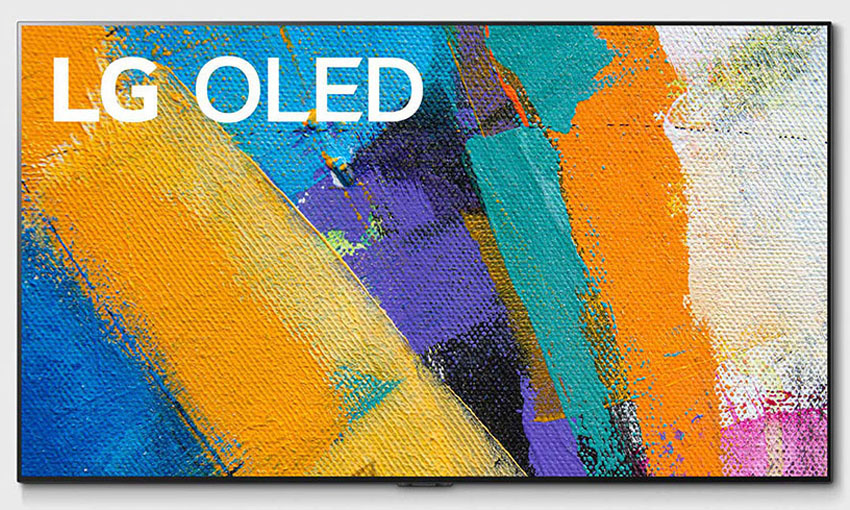
Type : Flat
The LG GX is the second 4K OLED on offer this year (or third in line depending on where you categorize the LG RX) and comes with the same feature set as the LG WX and represents the Gallery OLED that was made is such a way so you can hung it on the wall and keep everything hidden, no cables and no boxes visible.
The LG GX uses the same α9 Gen 3 AI Processor 4K, supports the same features like Dolby Vision IQ, Hands-free voice, Filmmaker Mode, HGiG Mode and comes with HDMI 2.1 ports that support not only eARC, ALLM and HFR but also VRR, FreeSync and G-Sync.
A 4.2CH 60W audio system is used with Dolby Atmos, OLED Surround and AI Sound Pro support while webOS 5.0 is present with all it’s features including ThinQ AI, voice control and streaming services.
Specifications
- 4K resolution (3,840 x 2,160)
- OLED display technology
- Wide Viewing Angle
- α9 Gen 3 AI Processor 4K
- HDR10, Dolby Vision, HLG
- 120Hz Refresh Rate
- VRR, FreeSync, G-Sync, ALLM, HFR
- 4.2CH 60W / Dolby Atmos, OLED Surround, AI Sound Pro
- Dolby Vision IQ, Hands-free voice, Filmmaker Mode, HGiG Mode
- 4 x HDMI 2.1 / 3 x USB 2.0
- ARC, eARC
- WiFi (802.11ac), Bluetooth v5.0
- webOS 5.0
- Google Assistant, Amazon Alexa, LG ThinQ AI
- ATSC 3.0 / DVB-T2/S2/C (Depending the region)
LG CX
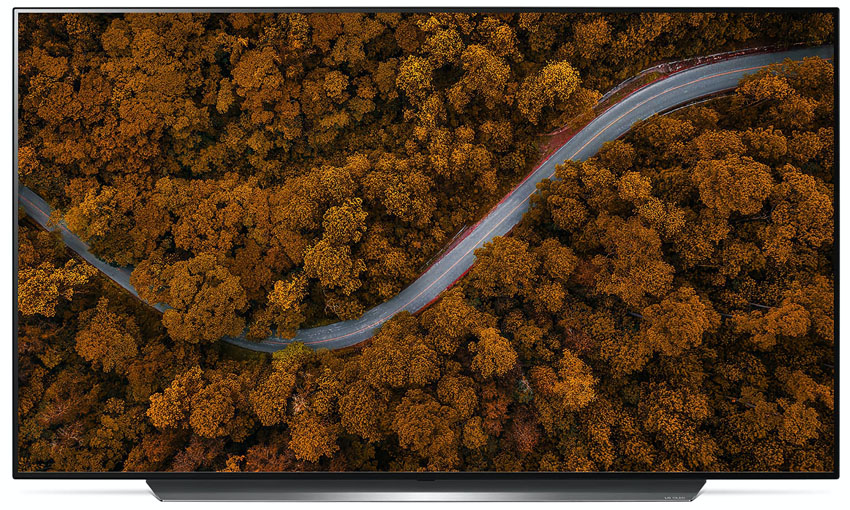
Type : Flat
The LG CX is the successor to the highly successful LG C9 and basically comes with most features we get in the top tier OLEDs but with a less capable audio system and that’s the reason why this model is preferred by so many people.
The LG CX uses the same α9 Gen 3 AI Processor 4K, supports the same features we find in the other OLEDs like Dolby Vision IQ, Hands-free voice, Filmmaker Mode and HGiG Mode and comes with HDMI 2.1 ports that support not only eARC, ALLM and HFR but also VRR, FreeSync and G-Sync.
It features a less capable audio system as the one we get has 2.2 channels with 40 watts of total power but as most people will certainly use a dedicated audio system this is hardly a problem here. Nevertheless the one available supports Dolby Atmos, OLED Surround and AI Sound Pro while we also get the full webOS treatment with all its streaming and smart TV capabilities like voice control, ThinQ AI and smart integration.
The C line strikes the perfect balance between price and quality and we believe that for one more year it will be the choice of many that are serious for their home entertainment.
Read our full analysis of the LG CX HERE.
Specifications
- 4K resolution (3,840 x 2,160)
- OLED display technology
- Wide Viewing Angle
- α9 Gen 3 AI Processor 4K
- HDR10, Dolby Vision, HLG
- 120Hz Refresh Rate
- VRR, FreeSync, G-Sync, ALLM, HFR
- 2.2CH 40W / Dolby Atmos, OLED Surround, AI Sound Pro
- Dolby Vision IQ, Filmmaker Mode, HGiG Mode
- 4 x HDMI 2.1 / 3 x USB 2.0
- ARC, eARC
- WiFi (802.11ac), Bluetooth v5.0
- webOS 5.0
- Google Assistant, Amazon Alexa, LG ThinQ AI
- ATSC 1.0 / DVB-T2/S2/C (Depending the region)
LG BX

Type : Flat
The LG BX is the successor of 2019’s B9 and is basically the most affordable OLED you can get. It comes with most of the same features we find in the more expensive OLEDs and this means the same OLED panel, support for HDR10, DOlby Vision and HLG, the same features like Dolby Vision IQ, Filmmaker Mode and HGiG Mode while the inclusion of HDMI 2.1 brings features like VRR, FreeSync, G-Sync, ALLM and HFR.
The BX also supports Dolby Atmos although you shouldn’t expect much from it’s simple 2.2 channels audio system while webOS 5.0 comes with all it’s smart and streaming features available. The most glaring difference in the LG BX is the less capable processor with the a7 Gen 3 Processor 4K being the one used here which means that image quality gets a slight hit in some areas.
You can read more on this in our LG BX review.
Specifications
- 4K resolution (3,840 x 2,160)
- OLED display technology
- Wide Viewing Angle
- α7 Gen 3 Processor 4K
- HDR10, Dolby Vision, HLG
- 120Hz Refresh Rate
- VRR, FreeSync, G-Sync, ALLM, HFR
- 2.2CH 40W / Dolby Atmos, OLED Surround, AI Sound Pro
- Dolby Vision IQ, Filmmaker Mode, HGiG Mode
- 4 x HDMI (2 x 2.1) / 3 x USB 2.0
- ARC, eARC
- WiFi (802.11ac), Bluetooth v5.0
- webOS 5.0
- Google Assistant, Amazon Alexa, LG ThinQ AI
- ATSC 1.0 / DVB-T2/S2/C (Depending the region)
8K NanoCell TVs
LG NANO99
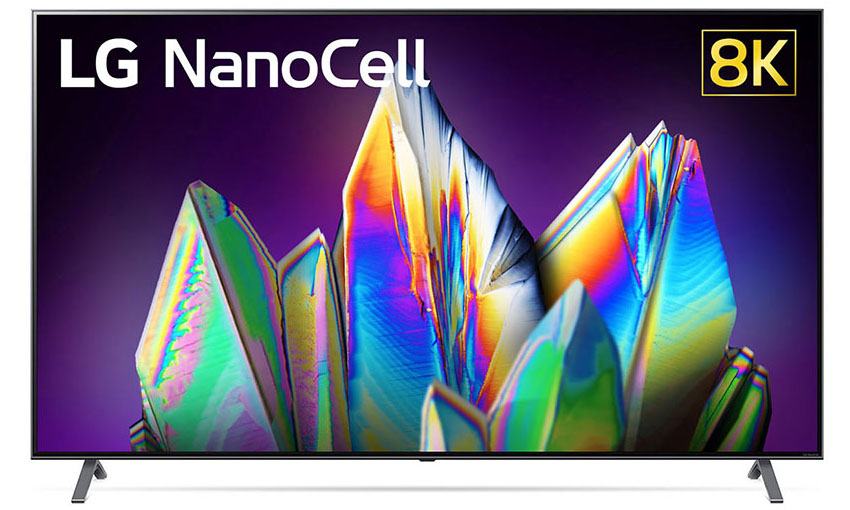
Type : Flat
Moving on into NanoCell territory now and for those unfamiliar they are the good old LED LCD TVs with an added NanoCell layer on the panel that is supposed to help with color reproduction. It’s basically a similar technology to Quantum Dot that Samsung is using, only with a different fancy name.
LG has released a trio of 8K NanoCells this year with the NANO99 being at the top of the performance ladder. This TV except from the NanoCell layer uses an advanced Full Array with Local Dimming (FALD Pro) light system which means better and more accurate light control, comes with an IPS panel which means better viewing angles than typical VA panels and uses the α9 Gen3 AI Processor 8K with all it’s advanced AI and upscaling features.
Everything else is pretty much the same as in the OLED TVs with features like Dolby Vision IQ, Hands-free voice, Filmmaker Mode and HGiG Mode included. Dolby Atmos, Ultra Surround and AI Sound Pro are also present with the use of a 4.2 channels audio system.
And while HDMI 2.1 is also present there is a reduction in the new ports as it seems that there are only two available with the rest being the older HDMI 2.0. We also loose support for VRR but at least we get ALLM and HFR. As far as it’s smart capabilities we get the full suite with webOS 5.0 and all it’s available features.
The NANO99 will come in two available sizes with 65″ and 75″ being the ones available.
Specifications
- 8K resolution (7,680 x 4,320)
- IPS display technology (NanoCell)
- Full Array backlight with Local Dimming (FALD Pro)
- Wide Viewing Angle
- α9 Gen3 AI Processor 8K
- HDR10, Dolby Vision, HLG
- 120Hz Refresh Rate
- ALLM, HFR
- 4.2CH 60W / Dolby Atmos, Ultra Surround, AI Sound Pro
- Dolby Vision IQ, Hands-free voice, Filmmaker Mode, HGiG Mode
- 4 x HDMI (2 x 2.1) / 3 x USB 2.0
- ARC, eARC
- WiFi (802.11ac), Bluetooth v5.0
- webOS 5.0
- Google Assistant, Amazon Alexa, LG ThinQ AI
- ATSC 1.0 / DVB-T2/S2/C (Depending the region)
LG NANO97
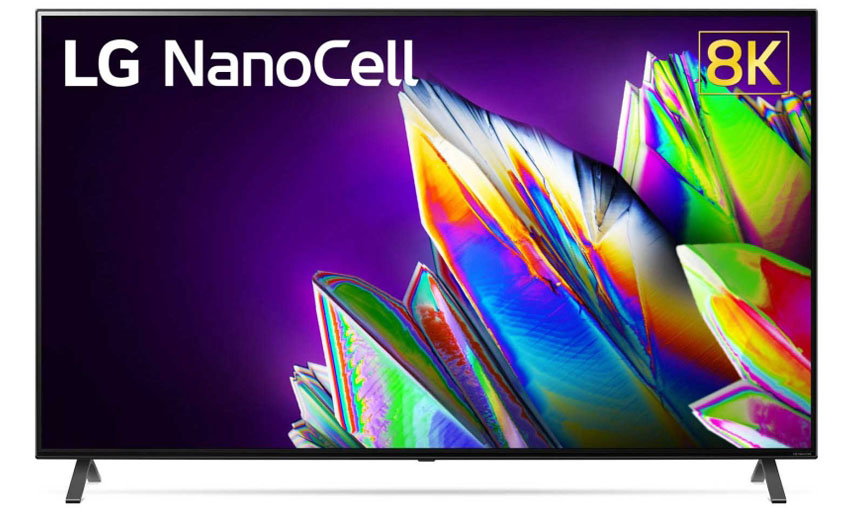
Type : Flat
Moving one step down we find the NANO97 which is extremely similar to the NANO99. In fact you will be hard to find any differences and it seems that the only one is that the NANO97 will be using the Simpler FALD light system instead of the FALD Pro variant used in NANO99. This means that most probably the NANO97 will have less available dimming zones and this means less accurate light control.
Everything else is the same as we find the same NAnoCell technology, the same a9 Gen 3 AI Processor 8K, the same 120Hz panel, support for Dolby Vision and Dolby Atmos, the same HDMI 2.1 ports and all available features including webOS 5.0 along with voice control and streaming capabilities.
Specifications
- 8K resolution (7,680 x 4,320)
- IPS display technology (NanoCell)
- Full Array backlight with Local Dimming (FALD)
- Wide Viewing Angle
- α9 Gen3 AI Processor 8K
- HDR10, Dolby Vision, HLG
- 120Hz Refresh Rate
- ALLM, HFR
- 4.2CH 60W / Dolby Atmos, Ultra Surround, AI Sound Pro
- Dolby Vision IQ, Hands-free voice, Filmmaker Mode, HGiG Mode
- 4 x HDMI (2 x 2.1) / 3 x USB 2.0
- ARC, eARC
- WiFi (802.11ac), Bluetooth v5.0
- webOS 5.0
- Google Assistant, Amazon Alexa, LG ThinQ AI
- ATSC 1.0 / DVB-T2/S2/C (Depending the region)
LG NANO95
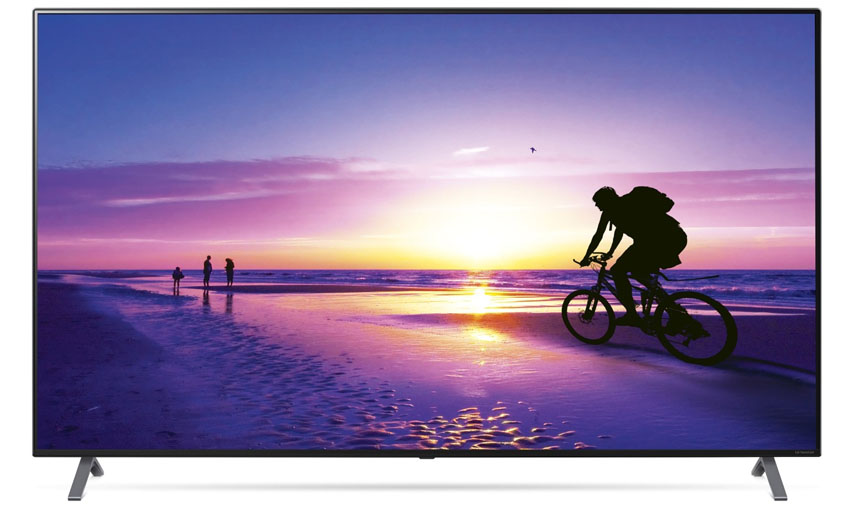
Type : Flat
The NANO95 is the last and most affordable 8K TV in 2020. Compared to the NANO97 above the NANO95 has two major differences. First of all it uses a 60Hz panel which means that motion performance will most certainly take a hit while it seems that it also uses a less capable audio system with the one included using 2.2 channels with 40 watts of power.
Everything else is the same as the NANO97 as it comes with the NanoCell layer and a9 Gen 3 Processor 8K, Dolby Atmos and Dolby Vision support, features ALLM and HFR and has a couple of HDMI 2.1 ports. webOS 5.0 is present in full swing so you are not missing anything in this regard. The NANO95 will come in two smaller sizes with 55″ and 65″ being available.
Specifications
- 8K resolution (7,680 x 4,320)
- IPS display technology (NanoCell)
- Full Array backlight with Local Dimming (FALD)
- Wide Viewing Angle
- α9 Gen3 AI Processor 8K
- HDR10, Dolby Vision, HLG
- 60Hz Refresh Rate
- ALLM, HFR
- 2.2CH 40W / Dolby Atmos, Ultra Surround, AI Sound Pro
- Dolby Vision IQ, Hands-free voice, Filmmaker Mode, HGiG Mode
- 4 x HDMI (2 x 2.1) / 3 x USB 2.0
- ARC, eARC
- WiFi (802.11ac), Bluetooth v5.0
- webOS 5.0
- Google Assistant, Amazon Alexa, LG ThinQ AI
- ATSC 1.0 / DVB-T2/S2/C (Depending the region)
4K NanoCell TVs
LG NANO91
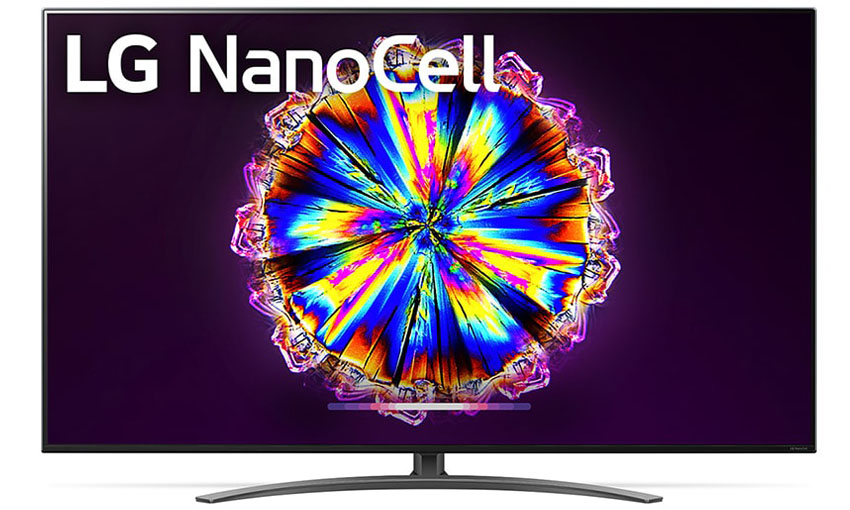
Type : Flat
Moving on we find the NANO91 which is the top 4K NanoCell for 2020. With the NANO91 we get a 4K TV that uses an IPS panel with 120Hz refresh rate which provides better viewing angles, comes with a Full Array with Local Dimming (FALD) light system for more accurate light control while processing duties takes the a7 Gen 3 Processor 4K which is a less capable variant of the a9 processor we saw in the OLED and 8K TV models.
The NANO91 supports the usual HDR10, Dolby Vision and HLG and comes with various features that the 8K NanoCells were missing like VRR and FreeSync while there is also ALLM and HFR support. More features include Dolby Vision IQ, Filmmaker Mode and HGiG Mode while webOS 5.0 comes fully featured.
HDMI 2.1 is available with NANO91 having two of them while the other two are the older 2.0 variant. Moving on to more consumer friendly models means that there are also more sizes available as the NANO91 will be released in four different sizes.
Specifications
- 4K resolution (3,840 x 2,160)
- IPS display technology (NanoCell)
- Full Array backlight with Local Dimming (FALD)
- Wide Viewing Angle
- α7 Gen 3 Processor 4K
- HDR10, Dolby Vision, HLG
- 120Hz Refresh Rate
- VRR, FreeSync, ALLM, HFR
- 2.2CH 40W (65″ 2.0CH 20W) / Dolby Atmos, Ultra Surround, AI Sound
- Dolby Vision IQ, Filmmaker Mode, HGiG Mode
- 4 x HDMI (2 x 2.1) / 3 x USB 2.0
- ARC, eARC
- WiFi (802.11ac), Bluetooth v5.0
- webOS 5.0
- Google Assistant, Amazon Alexa, LG ThinQ AI
- ATSC 1.0 / DVB-T2/S2/C (Depending the region)
LG NANO90
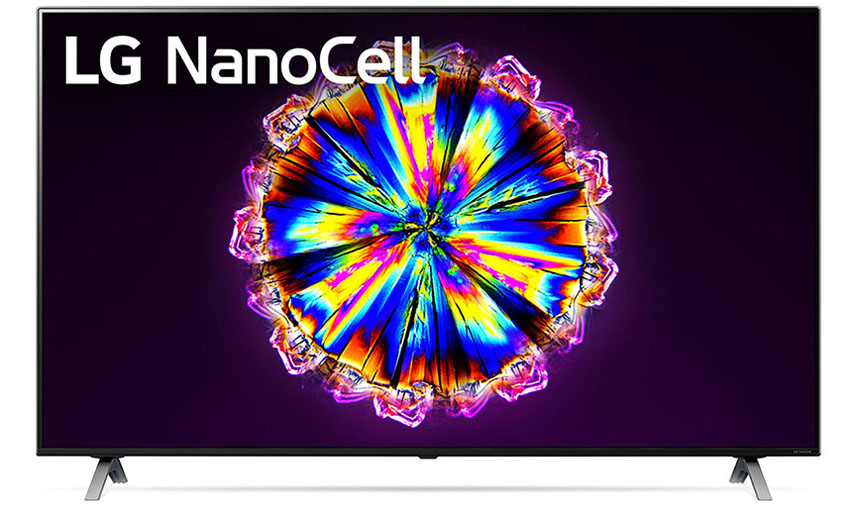
Type : Flat
Next in line is the NANO90 and this model comes with exactly the same features as the NANO91 above. Except from the different stand we failed to find any other differences between them as both of them come with the exact same specs and features so it seems that these two models will most likely be released in different markets although they both seem to have US and European model numbers.
With this in mind the NANO90 uses an IPS panel with 120Hz refresh rate which provides better viewing angles, comes with a Full Array with Local Dimming (FALD) light system for more accurate light control while processing duties takes the a7 Gen 3 Processor 4K.
The NANO90 supports the usual HDR10, Dolby Vision and HLG and comes with various features that the NANO91 also supports like VRR and FreeSync while there is also ALLM and HFR available. More features include Dolby Vision IQ, Filmmaker Mode and HGiG Mode while webOS 5.0 comes fully featured.
HDMI 2.1 is available with NANO90 having two of them while the other two are the older 2.0 variant. The NANO90 will also be released in four different sizes.
Specifications
- 4K resolution (3,840 x 2,160)
- IPS display technology (NanoCell)
- Full Array backlight with Local Dimming (FALD)
- Wide Viewing Angle
- α7 Gen 3 Processor 4K
- HDR10, Dolby Vision, HLG
- 120Hz Refresh Rate
- VRR, FreeSync, ALLM, HFR
- 2.2CH 40W (55″, 65″ 2.0CH 20W) / Dolby Atmos, Ultra Surround, AI Sound
- Dolby Vision IQ, Filmmaker Mode, HGiG Mode
- 4 x HDMI (2 x 2.1) / 3 x USB 2.0
- ARC, eARC
- WiFi (802.11ac), Bluetooth v5.0
- webOS 5.0
- Google Assistant, Amazon Alexa, LG ThinQ AI
- ATSC 1.0 / DVB-T2/S2/C (Depending the region)
LG NANO86
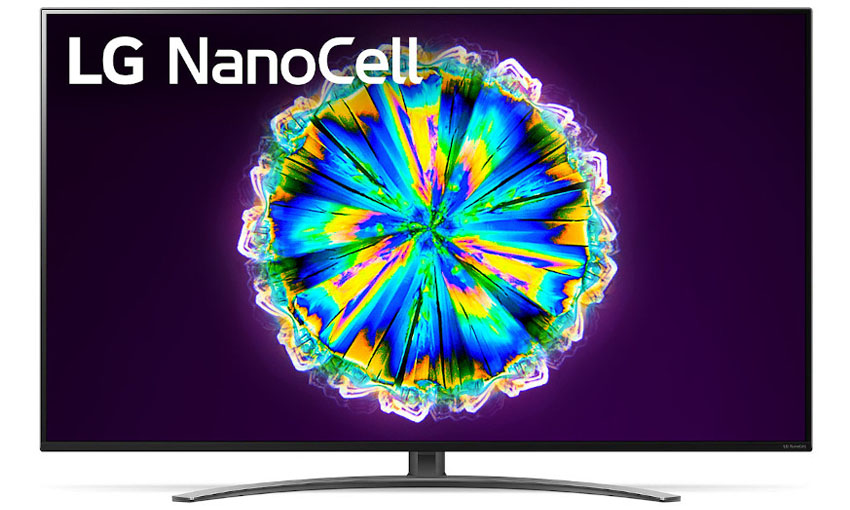
Type : Flat
The NANO86 seems to be a European model only and comes with many of the features the NANO90 and above featured with one major difference. The NANO86 switches from a FALD to an Edge LED with local dimming light system which means that light control is less accurate and brightness most probably will take a hit. The second noteworthy reduction is on the audio system used as the NANO86 uses a 2.0 channels system with 20 watts of power.
The rest of the specs are the same as above with NanoCell still being used, the a7 Gen 3 Processor 4K taking on processing duties and many features including Dolby Vision IQ, Filmmaker Mode, HGiG Mode, VRR, FreeSync, ALLM and HFR are available. HDMI 2.1 is still supported while webOS 5.0 is fully utilized.
Specifications
- 4K resolution (3,840 x 2,160)
- IPS display technology (NanoCell)
- Edge LED backlight with Local Dimming
- Wide Viewing Angle
- α7 Gen 3 Processor 4K
- HDR10, Dolby Vision, HLG
- 120Hz Refresh Rate
- VRR, FreeSync, ALLM, HFR
- 2.0CH 20W / Dolby Atmos, Ultra Surround, AI Sound
- Dolby Vision IQ, Filmmaker Mode, HGiG Mode
- 4 x HDMI (2 x 2.1) / 3 x USB 2.0
- ARC, eARC
- WiFi (802.11ac), Bluetooth v5.0
- webOS 5.0
- Google Assistant, Amazon Alexa, LG ThinQ AI
- ATSC 1.0 / DVB-T2/S2/C (Depending the region)
LG NANO85
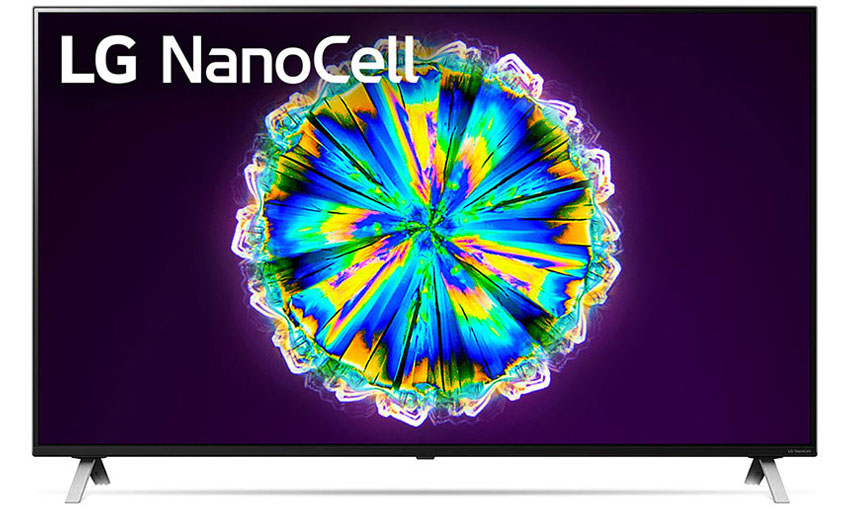
Type : Flat
NANO85 seems to be exactly the same model as the NANO86 above with the only difference being the stand used and this one will also be available in the US market.
As such we find an Edge LED with local dimming light system which means that light control is less accurate and brightness most probably will take a hit. Also, as the NANO86, it uses a 2.0 channels system with 20 watts of power.
The rest of the specs are the same as above with NanoCell still being used, the a7 Gen 3 Processor 4K taking on processing duties like many features including Dolby Vision IQ, Filmmaker Mode, HGiG Mode, VRR, FreeSync, ALLM and HFR are available. HDMI 2.1 is still supported while webOS 5.0 is fully utilized.
Specifications
- 4K resolution (3,840 x 2,160)
- IPS display technology (NanoCell)
- Edge LED backlight with Local Dimming
- Wide Viewing Angle
- α7 Gen 3 Processor 4K
- HDR10, Dolby Vision, HLG
- 120Hz Refresh Rate
- VRR, FreeSync, ALLM, HFR
- 2.0CH 20W / Dolby Atmos, Ultra Surround, AI Sound
- Dolby Vision IQ, Filmmaker Mode, HGiG Mode
- 4 x HDMI (2 x 2.1) / 3 x USB 2.0
- ARC, eARC
- WiFi (802.11ac), Bluetooth v5.0
- webOS 5.0
- Google Assistant, Amazon Alexa, LG ThinQ AI
- ATSC 1.0 / DVB-T2/S2/C (Depending the region)
LG NANO81 / NANO80
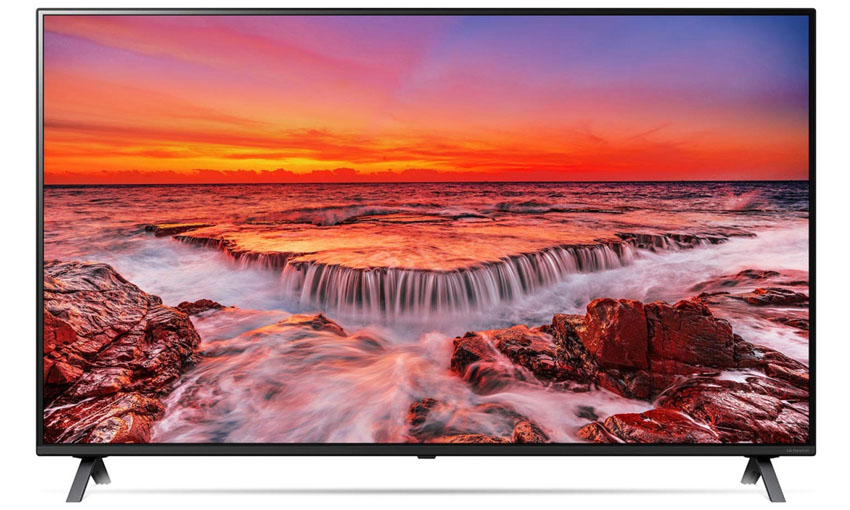
Type : Flat
Last in the NanoCell lineup we find the NANO81 and NANO80 and these two seem to be pretty much the same with the two different names being used most probably in different regions.
These two models come with certain reductions in their specs compared to the NANO85 above it. First of all it looses the a7 processor and has to settle with a less capable quad core processor of unknown capabilities. We also loose Dolby Vision as well as Dolby Atmos while extra features that are supported include Filmmaker Mode, HGiG Mode and ALLM. Everything else has been taken out.
We also loose all HDMI 2.1 ports and we have to do with the older HDMI 2.0 while eARC is also missing and the TV only supports the ARC function. At least we still get webOS 5.0 with all it’s available features and functionality.
Specifications
- 4K resolution (3,840 x 2,160)
- IPS display technology (NanoCell)
- Edge LED backlight with Local Dimming
- Wide Viewing Angle
- Quad Core Processor 4K
- HDR10, HLG
- 120Hz Refresh Rate
- ALLM
- 2.0CH 20W / Ultra Surround, AI Sound
- Filmmaker Mode, HGiG Mode
- 4 x HDMI 2.0 / 3 x USB 2.0
- ARC
- WiFi (802.11ac), Bluetooth v5.0
- webOS 5.0
- Google Assistant, Amazon Alexa, LG ThinQ AI
- ATSC 1.0 / DVB-T2/S2/C (Depending the region)
4K UHD LCD TVs
LG UN85
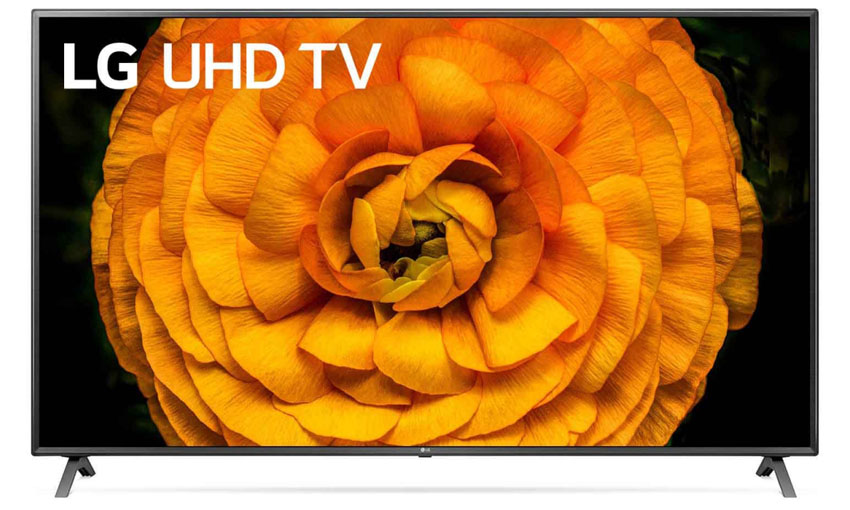
Type : Flat
Moving on to the budget friendly 4K UHD lineup we find the UN85 at the top which is the first model that looses the NanoCell layer that provides better and more accurate colors. This TV uses an IPS panel which means good viewing angles (except from the 82″ size that goes for a VA panel), has a 120Hz refresh rate and is the only 4K UHD TV that uses the a7 Gen 3 Processor 4K. It is also the only model in this lineup that keeps support for both Dolby Vision and Dolby Atmos while some extra features included are Dolby Vision IQ, Filmmaker Mode, HGiG Mode and ALLM.
The TV is the only one in the more low budget UN series that features two HDMI 2.1 ports while we also get eARC support and webOS 5.0 is still fully featured. This is also the first TV model that goes for a Direct LED system instead of the Edge LED system we got in some of the lower tier NanoCells and this is the standard light system being used in all the 4K UHD lineup.
For the full review click on the link HERE.
Specifications
- 4K resolution (3,840 x 2,160)
- IPS display technology (LED LCD) – (82″ VA panel)
- Direct LED
- Wide Viewing Angle (82″ No)
- α7 Gen 3 Processor 4K
- HDR10, Dolby Vision, HLG
- 120Hz Refresh Rate
- ALLM
- 2.0CH 20W / Dolby Atmos, Ultra Surround, AI Sound
- Dolby Vision IQ, Filmmaker Mode, HGiG Mode
- 4 x HDMI (2 x 2.1, 2 x 2.0) / 3 x USB 2.0
- ARC, eARC
- WiFi (802.11ac), Bluetooth v5.0
- webOS 5.0
- Google Assistant, Amazon Alexa, LG ThinQ AI
- ATSC 1.0 / DVB-T2/S2/C (Depending the region)
LG UN81
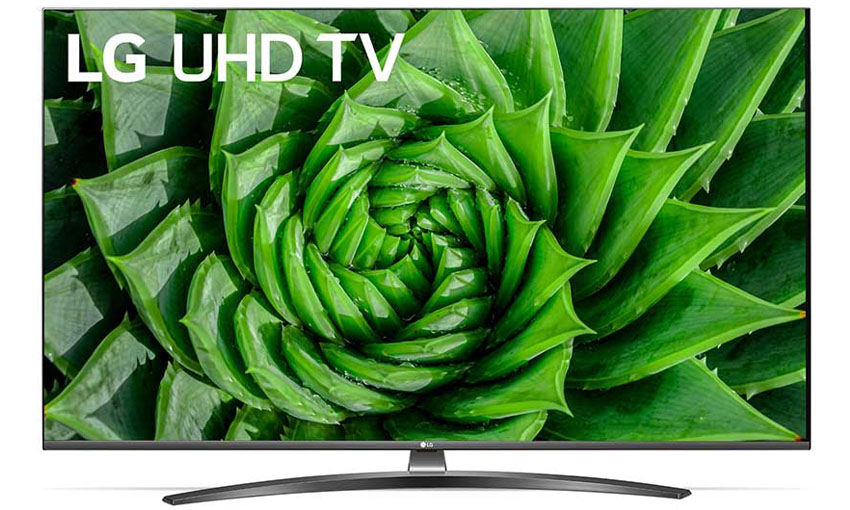
Type : Flat
The UN81 seems to be a European only model and uses an IPS panel for better viewing angles but goes for a 50Hz refresh rate which means lower motion performance. Processing duties are handled by a quad core processor 4K while extra features supported include Filmmaker Mode, HGiG Mode and ALLM. There is no Dolby Vision or Dolby Atmos here and also there is no HDMI 2.1 or eARC and instead we only get the older ARC function. It seems that the UN81 is also loosing one USB port as it has only two available instead of three that we found in the models above.
Specifications
- 4K resolution (3,840 x 2,160)
- IPS display technology (LED LCD)
- Direct LED
- Wide Viewing Angle
- Quad Core Processor 4K
- HDR10, HLG
- 50Hz Refresh Rate
- ALLM
- 2.0CH 20W / Ultra Surround, AI Sound
- Filmmaker Mode, HGiG Mode
- 4 x HDMI 2.0 / 2 x USB 2.0
- ARC
- WiFi (802.11ac), Bluetooth v5.0
- webOS 5.0
- Google Assistant, Amazon Alexa, LG ThinQ AI
- DVB-T2/S2/C (Depending the region)
LG UN80
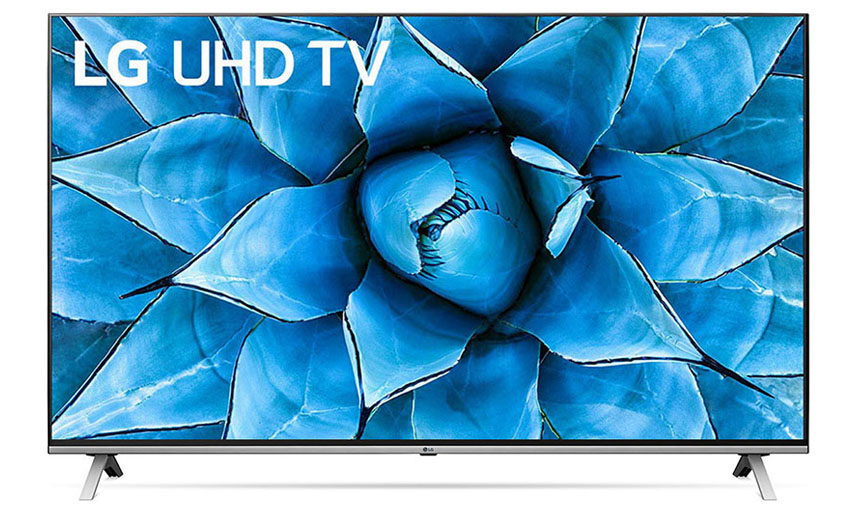
Type : Flat
The UN80 is another middle to lower tier 4K UHD TV that will be released in some European markets. The only visible difference is the stand design while all the other specifications are like for like with the UN81 above.
Specifications
- 4K resolution (3,840 x 2,160)
- IPS display technology (LED LCD) (50″ VA panel)
- Direct LED
- Wide Viewing Angle (50″ No)
- Quad Core Processor 4K
- HDR10, HLG
- 50Hz Refresh Rate
- ALLM
- 2.0CH 20W / Ultra Surround, AI Sound
- Filmmaker Mode, HGiG Mode
- 4 x HDMI 2.0 / 2 x USB 2.0
- ARC
- WiFi (802.11ac), Bluetooth v5.0
- webOS 5.0
- Google Assistant, Amazon Alexa, LG ThinQ AI
- DVB-T2/S2/C (Depending the region)
LG UN74
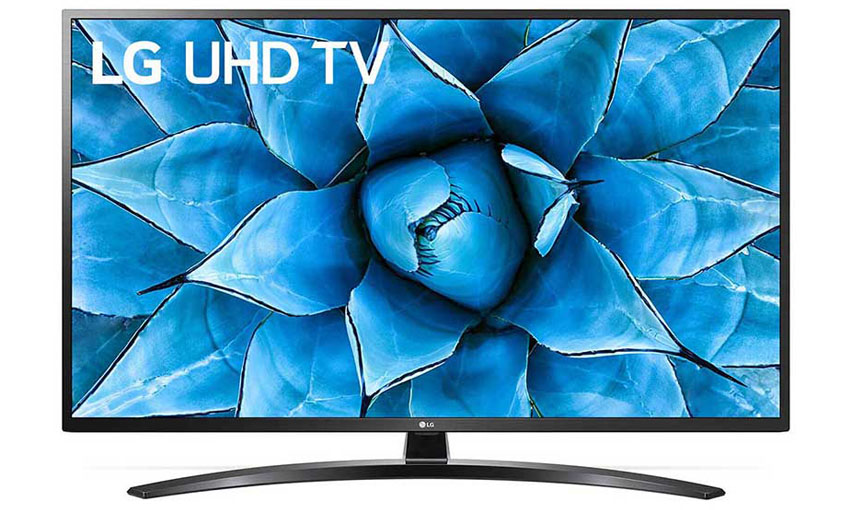
Type : Flat
Next in line we find the third European only model with the UN74 having only two visible differences with the UN80 above. One being the stand design and the other being the use of three HDMI ports instead of four available in the UN80. Everything else seems to be the same.
Specifications
- 4K resolution (3,840 x 2,160)
- IPS display technology (LED LCD) (50″ VA panel)
- Direct LED
- Wide Viewing Angle (50″ No)
- Quad Core Processor 4K
- HDR10, HLG
- 50Hz Refresh Rate
- ALLM
- 2.0CH 20W / Ultra Surround, AI Sound
- Filmmaker Mode, HGiG Mode
- 3 x HDMI 2.0 / 2 x USB 2.0
- ARC
- WiFi (802.11ac), Bluetooth v5.0
- webOS 5.0
- Google Assistant, Amazon Alexa, LG ThinQ AI
- DVB-T2/S2/C (Depending the region)
LG UN73
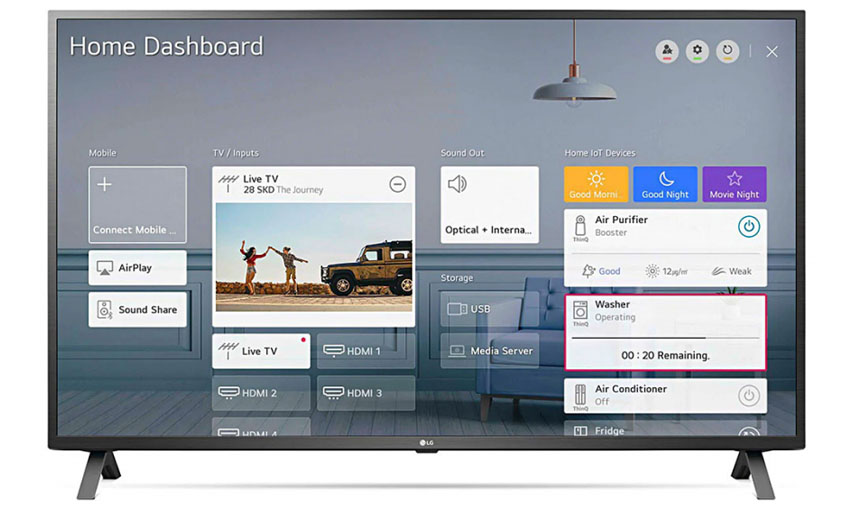
Type : Flat
The UN73 seems to be the exact same model as the UN74 above but it seems that this one will also be available in the US market and comes with just a different stand design. All other specs are the same and so will most probably be it’s image and motion performance.
You are read our in-depth analysis of the LG UN7300 HERE.
Specifications
- 4K resolution (3,840 x 2,160)
- IPS display technology (LED LCD)
- Direct LED
- Wide Viewing Angle
- Quad Core Processor 4K
- HDR10, HLG
- 50/60Hz Refresh Rate (Depending on region)
- ALLM
- 2.0CH 20W / Ultra Surround, AI Sound
- Filmmaker Mode, HGiG Mode
- 3 x HDMI 2.0 / 2 x USB 2.0
- ARC
- WiFi (802.11ac), Bluetooth v5.0
- webOS 5.0
- Google Assistant, Amazon Alexa, LG ThinQ AI
- ATSC 1.0 / DVB-T2/S2/C (Depending the region)
LG UN71
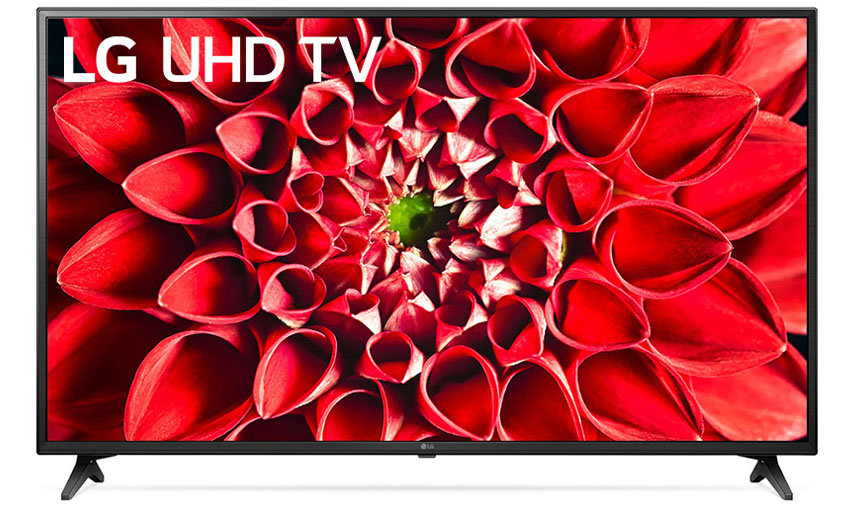
Type : Flat
The UN71 is another European only model and it terms of specs it is exactly the same as the UN73 and UN74. The only difference seems to be the slightly different bench type stand being used while the rest of the specs are exactly the same. It also seems that the UN71 is the last TV model that includes the fully featured webOS 5.0 with all it’s smart TV and streaming capabilities.
Specifications
- 4K resolution (3,840 x 2,160)
- IPS display technology (LED LCD)
- Direct LED
- Wide Viewing Angle
- Quad Core Processor 4K
- HDR10, HLG
- 50Hz Refresh Rate
- ALLM
- 2.0CH 20W / Ultra Surround, AI Sound
- Filmmaker Mode, HGiG Mode
- 3 x HDMI 2.0 / 2 x USB 2.0
- ARC
- WiFi (802.11ac), Bluetooth v5.0
- webOS 5.0
- Google Assistant, Amazon Alexa, LG ThinQ AI
- DVB-T2/S2/C (Depending the region)
LG UN70

Type : Flat
The UN70 is another lower tier 4K UHD TV and this is the first model that features a less feature complete webOS 5.0 as there are certain features like LG’s ThinQ AI missing. It seems that the UN70 is also loosing Bluetooth support as well as the Filmmaker mode we found in all the models above. The UN70 will be available in a single size with the 50″ being the only one available.
Specifications
- 4K resolution (3,840 x 2,160)
- VA display technology (LED LCD)
- Direct LED
- Quad Core Processor 4K
- HDR10, HLG
- 60Hz Refresh Rate
- ALLM
- 2.0CH 20W / Ultra Surround, AI Sound
- HGiG Mode
- 3 x HDMI 2.0 / 2 x USB 2.0
- ARC
- WiFi (802.11ac)
- webOS 5.0
- Google Assistant, Amazon Alexa
- ATSC 1.0
LG UN69

Type : Flat
The UN69 is the last model and most affordable 4K TV LG has on offer in 2020 and seems like it will only be released in the US market. The UN69 is similar in specs with the UN70 and features limited specs and functionality making it an excellent low cost suggestion for those that don’t care about features or image performance and just want a simple TV for broadcasting.
Specifications
- 4K resolution (3,840 x 2,160)
- IPS display technology (LED LCD) (50″ VA panel)
- Direct LED
- Wide Viewing Angle
- Quad Core Processor 4K
- HDR10, HLG
- 60Hz Refresh Rate
- ALLM
- 2.0CH 20W / Ultra Surround, AI Sound
- HGiG Mode
- 3 x HDMI 2.0 / 2 x USB 2.0
- ARC
- WiFi (802.11ac)
- webOS 5.0
- Google Assistant, Amazon Alexa
- ATSC 1.0
The rest…
LG RX
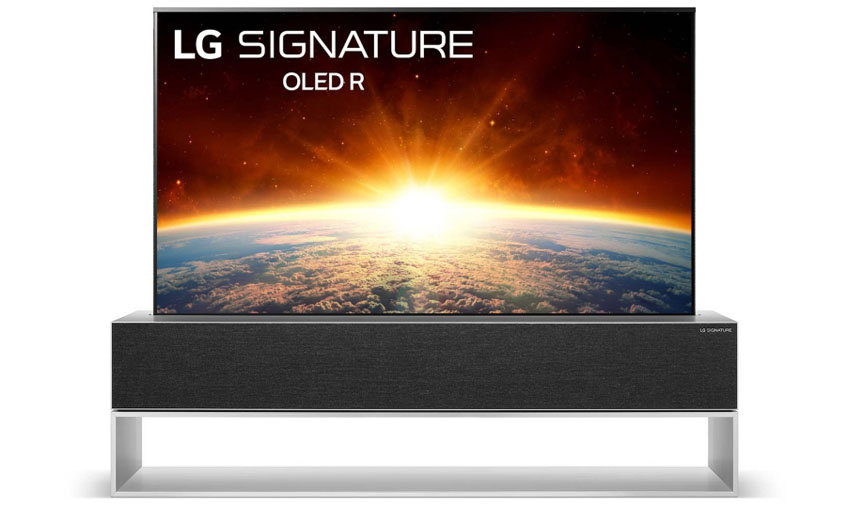
Type : Rollable
For last we left the LG RX which basically is considered part of the OLED family but because this is a special model we decided to mention it separately from the rest. The LG RX is the first rollable TV from LG and although this had already been announced from last year it seems that 2020 will finally be the year that we are going to see it being available worldwide.
It comes with most of the features included in the other OLEDs but there are a few glaring omissions like VRR, FreeSync and G-Sync. Obviously the feature that sets this apart from all the other models, and from all other TVs in general we might say, is it’s rollable design as the panel has the ability to roll inside it’s special made furniture making it completely invisible when not in use. This is the beginning of a new era and we are curious to see if consumers will embrace this new design or will end up being another gimmick that most will ignore.
Specifications
- 4K resolution (3,840 x 2,160)
- OLED display technology
- Wide Viewing Angle
- α9 Gen 3 AI Processor 4K
- HDR10, Dolby Vision, HLG
- 120Hz Refresh Rate
- ALLM, HFR
- 4.2CH 100W / Dolby Atmos, OLED Surround, AI Sound Pro
- Rollable, Dolby Vision IQ, Hands-free voice, Filmmaker Mode, HGiG Mode
- 4 x HDMI 2.1 / 3 x USB 2.0
- ARC, eARC
- WiFi (802.11ac), Bluetooth v5.0
- webOS 5.0
- Google Assistant, Amazon Alexa, LG ThinQ AI
- ATSC 3.0 / DVB-T2/S2/C (Depending the region)
OLED TVs
NanoCell TVs
4K UHD TVs

I’m a very big fan of LG products and since I’ve been earning to purchase my own electronics, LG has been my choice. I love the durability and the sense of design they have. You have made an amazing job in listing all available ones for this year. I would love an OLED but they are a bit too expensive for me so I am probably going to get a NanoCell with a FALD system. I am definitely bookmarking your page for when the time comes. Thanks.
You are welcome. If you need any help when the time comes to choose let me know.
It’s a shame that they start to put more attention to 8K TVs when there is no real content for them yet. And with such a high price these are mostly for those few that have unlimited budget. The LG CX is still in my opinion the best one to get this year as it has been the last few years.
I agree that the C line is the best and many will go for it for one more year.
I’m looking for a new budget tv, and I can’t decide whether I should spend $400 on the Samsung UE50TU7005 or $500 on the LG 50UN8006 (with a VA panel). Any thoughts?
Hello Mathias. Unfortunately from the two only the Samsung we have thoroughly tested so I cannot give you an answer based on our tests. Looking at the specs there are many similarities between the two and each one has certain advantages but I cannot have a clear image without knowing how the LG performs.